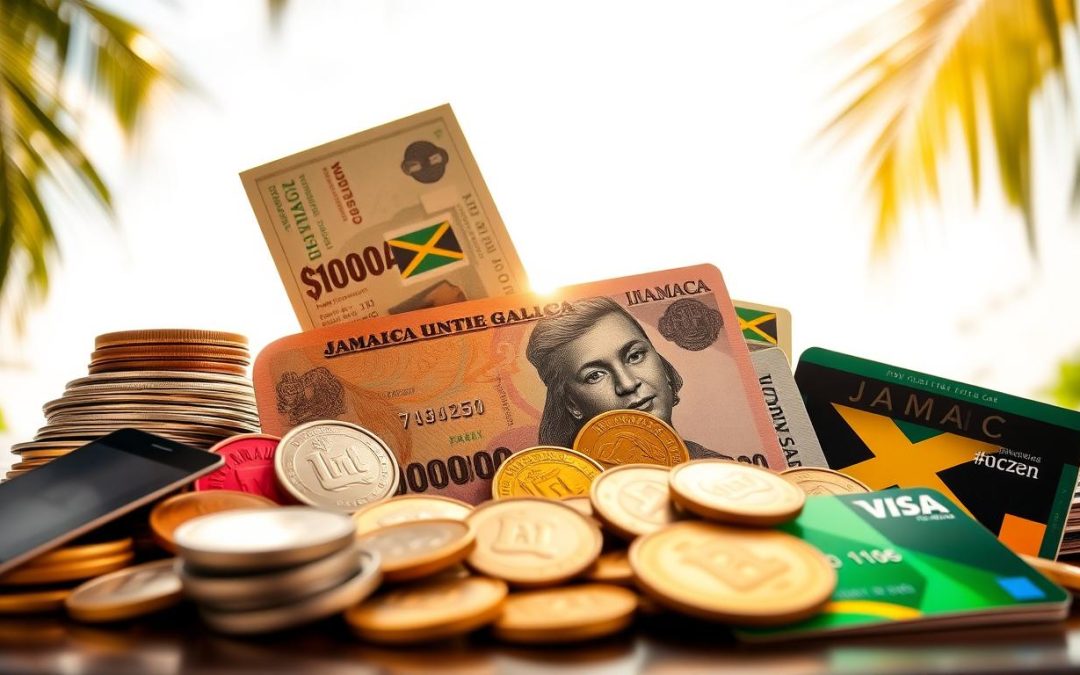Have you ever wondered how to manage your money efficiently while exploring a new destination? Understanding the local currency and payment methods can make or break your travel experience. In this guide, we’ll dive into everything you need to know about handling finances during your trip.
The official Jamaican dollar (JMD) is the primary currency used across the island. While US dollars are often accepted in tourist hotspots, having JMD on hand is essential for smaller purchases and local experiences. Combining cash and card usage ensures you’re prepared for any situation, from bustling markets to upscale restaurants.
This guide will walk you through the history of the Jamaican dollar, practical tips for exchanging money, and how to navigate payment options seamlessly. By the end, you’ll feel confident and ready to enjoy your trip without financial stress.
Key Takeaways
- The Jamaican dollar (JMD) is the official currency.
- US dollars are widely accepted in tourist areas.
- Carry a mix of cash and cards for convenience.
- Exchange money at local banks or Cambio centers for better rates.
- Stay alert when using ATMs or handling cash in busy areas.
Overview of Jamaican Currency and Travel Preparation
Planning your finances before traveling can save you time and money during your trip. Understanding the local currency and how to exchange it efficiently is key to a stress-free experience. This section will guide you through the essentials of handling money while exploring the island.
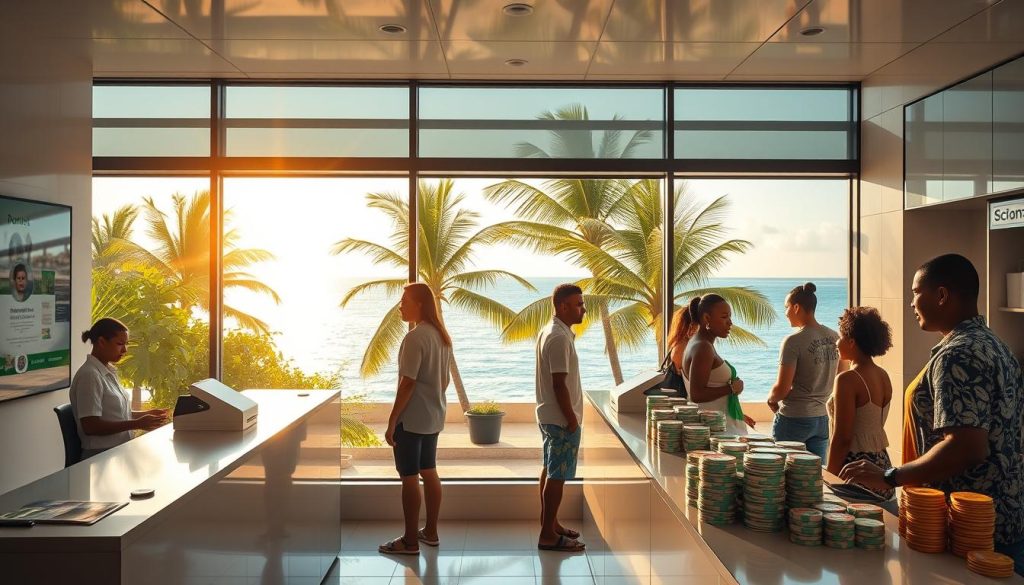
Why Currency Matters When Visiting Jamaica
Carrying the correct currency makes a big difference in convenience and cost savings. The Jamaican dollar (JMD) is the official currency, and while US dollars are accepted in tourist areas, using JMD is often cheaper. Paying in local currency helps you avoid additional fees that come with foreign transactions.
Having a mix of cash and cards ensures you’re prepared for any situation. Cash is essential for smaller purchases, tipping, and local markets, while cards are convenient for larger expenses. This balance helps you stay flexible and secure.
Essential Tips for Smooth Currency Exchange
Exchanging money at the right places can save you a lot. Avoid airport and hotel exchanges, as they often offer less favorable rates. Instead, use local banks or cambio centers for better deals. Here’s a quick comparison:
| Exchange Location | Exchange Rate | Convenience |
|---|---|---|
| Airport | Less Favorable | High |
| Local Bank | More Favorable | Medium |
| Cambio Center | Most Favorable | Low |
Always monitor exchange rates before your trip. Using a travel debit card, like the Wise Multi-Currency Card, can also help you save on conversion fees. These small steps can make a big difference in your travel budget.
By preparing ahead and choosing the right payment options, you can enjoy your trip without worrying about unexpected costs. Keep these tips in mind to make your financial experience as smooth as possible.
Jamaica: Ultimate Travelers Guide to Currencies & Payments
Exploring a new destination becomes smoother when you understand the local currency. The Jamaican dollar (JMD) is the official currency, and it plays a significant role in daily transactions. Introduced in 1969, it replaced the Jamaican pound, marking a shift in the island’s financial history.
The currency features vibrant designs that reflect the island’s culture and heritage. Denominations include J$50, J$100, J$500, J$1,000, J$2,000, and J$5,000. Each note showcases iconic figures, landmarks, and symbols, making them a unique part of your travel experience.
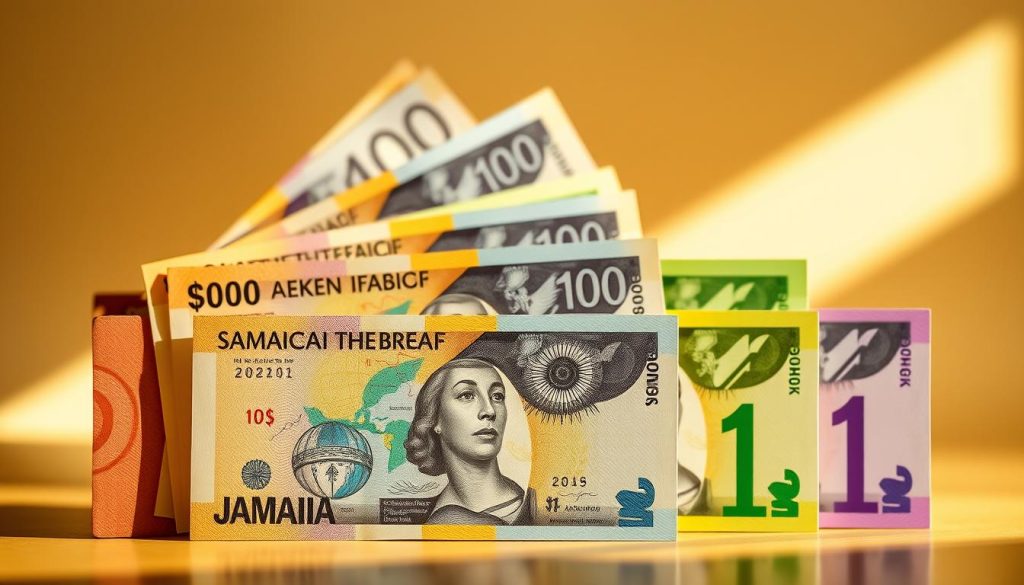
Using the local currency is often more cost-effective than relying on foreign money. It helps you avoid additional fees and ensures smoother transactions in local markets and smaller establishments. Always check the live exchange rate before converting your money to get the best deal.
Combining Cash and Card Payments for Flexibility
Having a mix of cash and cards is the best method for handling your finances. Cash is essential for small purchases, tipping, and local markets. Cards, on the other hand, are convenient for larger expenses and provide added security.
Here’s a quick comparison of payment options:
| Payment Method | Best For | Tips |
|---|---|---|
| Cash | Local markets, tipping, small purchases | Carry small denominations for convenience |
| Cards | Restaurants, hotels, larger expenses | Notify your bank before traveling to avoid issues |
Being informed about the best place to use each payment option saves you time and money. For example, cards are widely accepted in tourist areas, while cash is preferred in rural spots. This balance ensures you’re prepared for any situation.
By understanding the local currency and choosing the right payment method, you can enjoy a seamless financial experience. These tips will help you navigate the island with confidence and ease.
A Look into the History of Jamaica’s Currency
Understanding the roots of a country’s currency can give you a deeper appreciation for its culture and economy. The Jamaican dollar (JMD) has a rich history that reflects the island’s journey from colonial rule to independence. Introduced in 1969, it replaced the Jamaican pound, marking a significant shift in the nation’s financial identity.
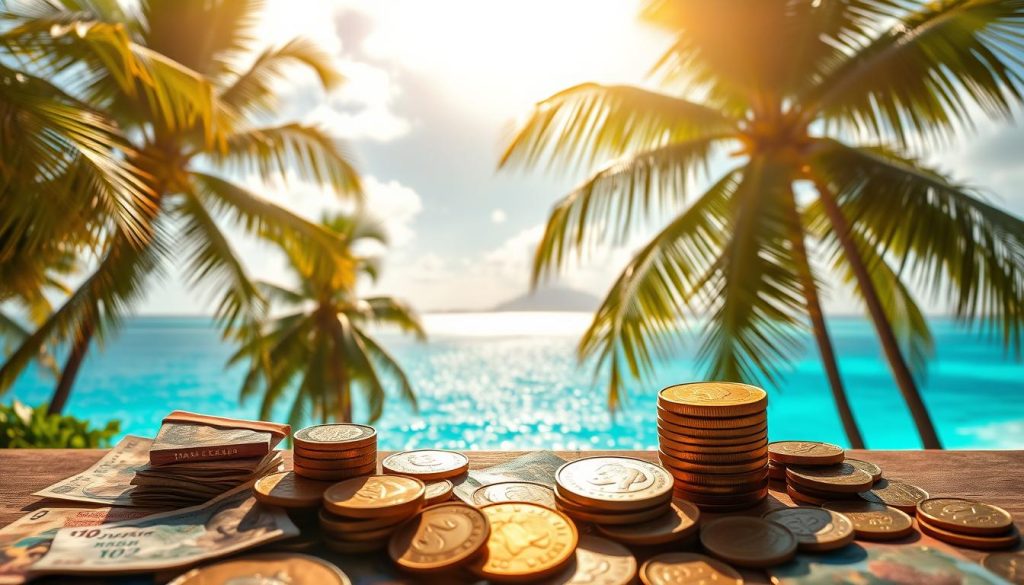
Transition from the Jamaican Pound to the Jamaican Dollar
Before 1969, the Jamaican pound was the official currency, tied to the British pound. The transition to the Jamaican dollar was a move toward economic independence. Initially, the JMD was equivalent in value to the US dollar, but over time, its value has fluctuated due to inflation and other economic factors.
Today, the Bank of Jamaica manages the currency, ensuring stability and regulating its circulation. This institution plays a crucial role in maintaining the value of the JMD, which is essential for both locals and visitors.
Cultural Inspirations in Currency Design
The Jamaican dollar is more than just money; it’s a canvas that showcases the island’s heritage. Each banknote features iconic figures, landmarks, and symbols that tell a story. For example, the $500 note honors Nanny of the Maroons, a national hero, while the $1000 note features Michael Norman Manley, a former prime minister.
These designs not only celebrate the island’s history but also make the currency a unique part of your travel experience. Carrying these notes is like holding a piece of Jamaican culture in your hands.
By learning about the history and design of the Jamaican dollar, you gain a better understanding of its value and significance. This knowledge can enhance your appreciation for the island’s rich heritage and make your financial transactions more meaningful.
Navigating Payment Methods on the Island
Managing your money wisely while traveling can make your trip smoother and more enjoyable. Understanding the best payment options ensures you’re prepared for any situation, whether you’re shopping at a local market or dining at a resort.
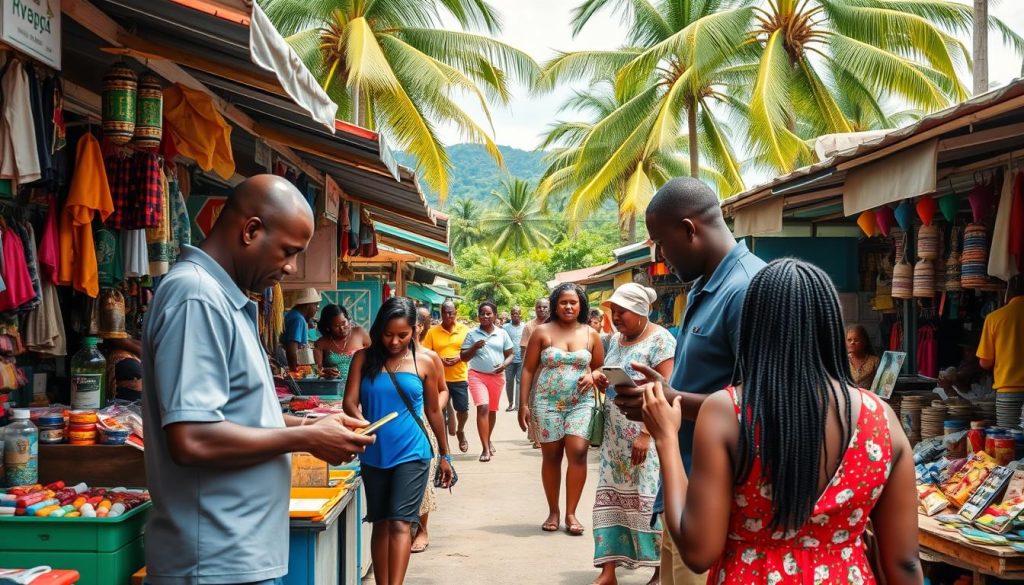
Using Debit and Credit Cards Safely
Cards are widely accepted in tourist areas and upscale establishments. Visa and Mastercard are the most common, but make sure to notify your bank before your trip to avoid unexpected blocks. Foreign transaction fees can add up, so check with your card issuer for details.
For added security, use cards for larger purchases and keep cash for smaller transactions. This approach minimizes risks and ensures you’re covered in case of loss or theft.
Tips for Cash Transactions in Local Markets
Cash remains the preferred payment option in rural areas and local markets. Carry small denominations for convenience, as vendors may not have change for larger bills. Exchanging money at local banks or ATMs often provides better rates than airport kiosks.
Be mindful of your surroundings when handling cash, especially in busy areas. Keeping your money secure ensures a stress-free shopping experience.
Digital Payment Platforms and Mobile Wallets
Digital payments are gaining popularity, especially in tourist-heavy zones. Platforms like PayPal and mobile wallets offer convenience and speed. However, not all establishments accept these methods, so it’s wise to have a backup plan.
Using digital services can also help you track expenses and manage your budget effectively. Just ensure you have a reliable internet connection to avoid interruptions.
By combining these payment options, you can enjoy a seamless financial experience during your trip. Whether you’re exploring a bustling market or relaxing at a resort, these tips will help you navigate the island with confidence.
Exchanging Money: Strategies for the Best Rates
Getting the best exchange rates can make your trip more enjoyable and cost-effective. Planning ahead and knowing where to exchange your money can save you from unnecessary fees and stress. Here’s how to ensure you get the most value for your currency exchange.
Pre-Trip Currency Exchange Tips
Exchanging money before you leave home often leads to better rates. Local banks and reputable bureaus like Western Union typically offer more favorable rates than airports or hotels. Compare rates at different locations to find the best deal.
Another tip is to check for foreign transaction fees on your cards. Some banks charge extra for international purchases, which can add up quickly. Using a travel debit card or multi-currency account can help you avoid these fees.
Using Local Banks and ATMs for Better Rates
Once you arrive at your destination, local banks and ATMs are your best bet for competitive rates. Avoid airport kiosks, as they often charge higher fees. Withdrawing cash in smaller amounts can also help you manage your budget better.
Here’s a quick comparison of exchange options:
| Exchange Location | Rate Quality | Convenience |
|---|---|---|
| Airport | Low | High |
| Local Bank | High | Medium |
| ATMs | High | Medium |
By following these strategies, you can maximize your currency exchange and enjoy a smoother travel experience. Whether you’re planning to shop or explore, these tips will help you stay prepared and save money.
Understanding Exchange Rates and Influencing Factors
Exchange rates play a big role in how much you spend abroad. Whether you’re withdrawing cash from an ATM or using a debit card, understanding these rates can save you money. The mid-market rate, often considered the fairest, is the benchmark for currency exchange. Monitoring this rate ensures you get the best deal.
Monitoring the Mid-Market USD/JMD Rate
The mid-market rate is the average between the buy and sell prices of currencies. For example, the USD to JMD rate fluctuates based on market demand. Tools like currency converter apps or financial websites can help you track this rate in real time. Staying informed allows you to exchange money at the right moment.
Here’s a quick comparison of exchange methods:
| Method | Pros | Cons |
|---|---|---|
| ATMs | Convenient, competitive rates | May charge foreign transaction fees |
| Banks | Reliable, secure | Less favorable rates than cambio centers |
| Travel Debit Cards | Low fees, easy to use | Requires pre-loading funds |
Key Economic Factors Affecting Exchange Rates
Several factors influence exchange rates, including inflation, interest rates, and economic stability. For instance, high inflation can weaken a currency, making it less valuable compared to others. Interest rates also play a role; higher rates attract foreign investors, boosting the currency’s value.
Understanding these factors helps you predict rate changes. For example, if a country’s economy is growing, its currency may strengthen. Keeping an eye on these trends ensures you exchange money at the best time.
Using modern tools like debit cards designed for travel can also help. These cards often offer better rates and lower fees compared to traditional methods. By combining knowledge of exchange rates with the right tools, you can save money and enjoy a stress-free trip.
Conclusion
Making the most of your trip starts with smart financial planning. Using the local currency ensures smoother transactions and helps you avoid unnecessary fees. Preparing your exchange money strategy in advance can save you time and money during your stay.
Carry a mix of cash and cards for flexibility. Exchange at local banks or ATMs for better rates, and avoid airport kiosks. These small steps can make a big difference in your budget.
By planning ahead, you can focus on enjoying your tour without financial stress. With the right preparation, your trip will be seamless and memorable.
The above is subject to change.
Check back often to TRAVEL.COM for the latest travel tips and deals.
Here are some Tours & Sightseeing suggestions that might pique your interests!
